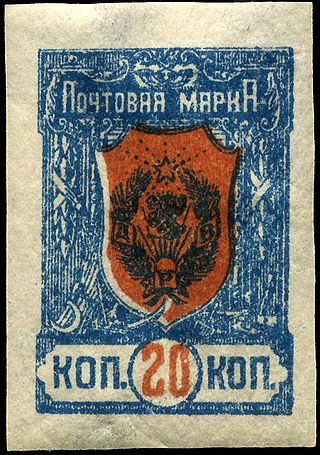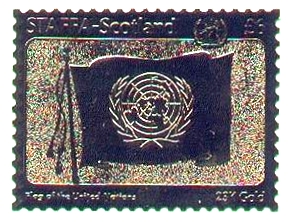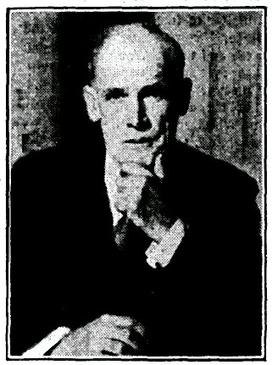
Philatelic literature is written material relating to philately, primarily information about postage stamps and postal history.

The Stanley Gibbons Group plc is a company quoted on the London Stock Exchange specialising in the retailing of collectable postage stamps and similar products. The group is incorporated in London. The company is a major stamp dealer and philatelic publisher. The company's philatelic subsidiary, Stanley Gibbons Limited, had a royal warrant of appointment from Queen Elizabeth II.

The Far Eastern Republic, sometimes called the Chita Republic, existed from April 1920 to November 1922 in the easternmost part of Siberia. It was formed from the Amur, Transbaikal, Kamchatka, Sakhalin, and Primorye regions. In theory, it extended from Lake Baikal to Vladivostok but, in May 1921, the Priamur and Maritime Provinces seceded. Although nominally independent, it was largely controlled by the RSFSR and its main purpose was to be a democratic buffer state between the RSFSR and the territories occupied by Japan during the Russian Civil War to avoid war with Japan. Initially, its capital was Verkhneudinsk, but from October 1920 it was Chita. On 15 November 1922, after the war ended and the Japanese withdrew from Vladivostok, the Far Eastern Republic was annexed by Soviet Russia.

The postage and revenue stamps of the United Kingdom issued in 1887 are known as the "Jubilee" issue because they were issued during the year of the Golden Jubilee of Queen Victoria to the throne in 1837. They continued in use throughout the remainder of Victoria's reign, and many of the designs were reused in the stamps of Edward VII. The Jubilee issue includes the first British stamps to be printed in two colours.

Edward Benjamin Evans, a British army officer also known as "Major Evans", was a distinguished philatelist, stamp collector, and philatelic journalist. His philatelic specialization included Mauritius, the Confederate States of America, the Mulready envelopes, and the Indian feudatory states.

James Negus was a British philatelist and book editor.

The postage stamps and postal history of Christmas Island, in the Indian Ocean, was linked to its original economic situation until 1993. Mainly ruled by a phosphate production commission, the island was part of the British Straits Settlements colony from 1901 to 1942, then of Singapore from 1946 to 1958. Although it was placed under Australian control in 1958, the island remained postally and philatelically independent until 1993 when Australia Post became the island's postal operator.
Bangladesh first issued its own postage stamps upon gaining independence in 1971. A set of eight stamps, with various motifs including a map of the country, were issued. Shortly after, stamps in eight values were overprinted "Bangladesh Liberated" in both English and Bengali were prepared in the United Kingdom, but only three values were issued in Bangladesh.

The Tuvan People's Republic issued postage stamps between 1926 and 1936. They were popular with stamp collectors in the Western world in the mid-twentieth century because of the obscurity and exoticism of Tannu Tuva and the stamps' quirky, colorful designs. The validity of many stamps purportedly issued by Tannu Tuva has been questioned by philatelists.

The Roll of Distinguished Philatelists (RDP) is a philatelic award of international scale, created by the Philatelic Congress of Great Britain in 1921. The Roll consists of five pieces of parchment to which the signatories add their names.
Charles James Phillips of London, England, and New York City, was a philatelist highly regarded in both England where he started his philatelic career and in the United States, where he emigrated to in 1922.

Frederick Stanley Phillips was a British philatelist and prolific philatelic author who signed the Roll of Distinguished Philatelists at Folkestone in 1937.

Clive Harold Feigenbaum (1939–2007) was a colourful and controversial British businessman who was involved in a lifelong series of scandals in the world of philately. Particularly notable was the sale of "gold" stamps from Staffa and his role in the collapse of attempts to list Stanley Gibbons on the Unlisted Securities Market in 1984.

Anthony Hugh Mostyn Jefferies, MBE, is a British philatelist, the former editor of Gibbons Stamp Monthly, and the current editor of the Stanley Gibbons stamp catalogue.

The Postal Union Congress (PUC) £1 stamp is one of a series of postage stamps of Great Britain issued in 1929. It is one of the classics of British philately and has been described as one of the most beautiful British stamps ever issued. The stamp was only the second British commemorative stamp to be issued. The first were the British Empire Exhibition postage stamps of 1924–25.
Douglas Garth was a British philatelist who was one of the "Fathers of Philately" entered on the Roll of Distinguished Philatelists in 1921. He was an expert on the stamps of India and British Guiana and a Solicitor in the firm of Pemberton & Garth. Garth was the second son of Sir Richard Garth (1820–1903), a former Chief-Justice of Bengal.
Julius Goldner was a nineteenth-century wholesale stamp dealer in Hamburg known for producing large quantities of "reprints" of the stamps of Hamburg and other states.

The Philatelic Exporter, established May 1945, was a trade magazine produced for the international stamp trade. It was published monthly by Stanley Gibbons who acquired the title in January 2009 from Heritage Studios Limited. It ceased publication in February 2023. The final editor was Alison Boyd. Previous editors included Arthur Stansfield followed by Graham Phillips.

Emil Carl Christiaan Tamsen was a South African philatelist, who was entered on the Roll of Distinguished Philatelists in 1921. He was also a signatory, in 1932, to the Roll of Distinguished Philatelists of Southern Africa. Tamsen was an expert in the stamps of Transvaal, about which he researched and wrote, and he was one of the founders in 1894 of the Johannesburg Philatelic Society.

John Alexander Agnew was a New Zealand mining engineer who worked with future United States president Herbert Hoover and later became chairman of Consolidated Gold Fields, the first chairman of the firm to be from a mining engineering background. In his spare time he was a noted philatelist whose collection of Chinese stamps and postal history was regarded as one of the finest of his era.
















